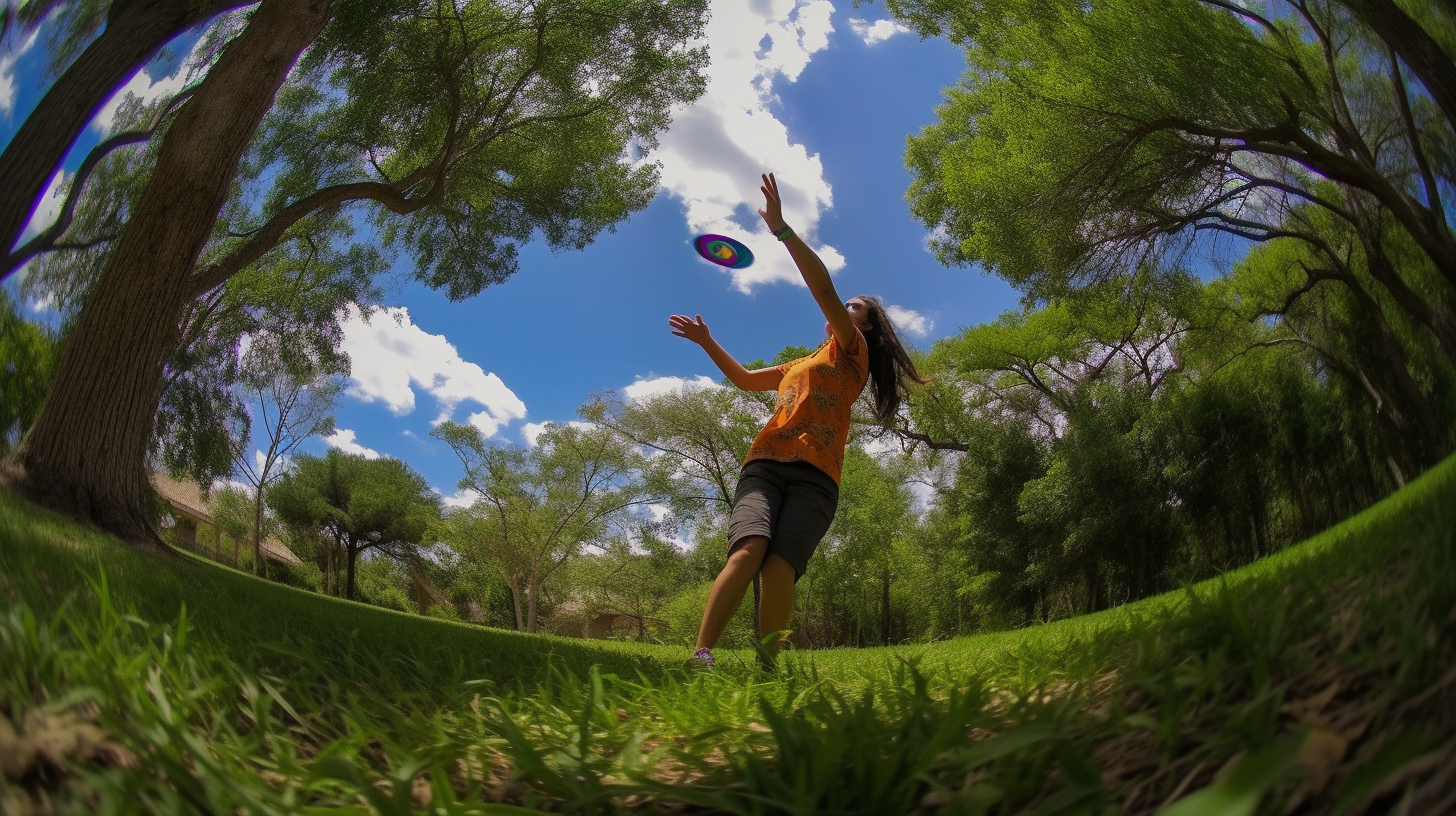Have you seen those colorful baskets in the park and wondered what game uses flying discs? Let’s unravel the basics behind this fast-growing sport – disc golf!
Disc golf adapts traditional golf into an accessible, environmentally sustainable game played with flying discs rather than clubs and balls.
With simple components and rules friendly to new players, disc golf delivers fun, exercise, and connection with nature.
Let’s dive into the essentials for playing disc golf effectively.
What Is Disc Golf?

Disc golf is a flying disc sport in which players throw a disc at a target. It shares similarities to traditional golf, except players use flying discs instead of balls and clubs.
The sport was formalized in the 1970s, originating from playing traditional golf courses using Frisbees. Today there are over 8,000 disc golf courses globally in dozens of countries.
The standard disc golf target is an elevated metal basket with chains to catch discs. Courses often have 9 or 18 holes, with players keeping score as in ball golf.
The goal is to traverse the course, from tee to basket, in the fewest total throws or “strokes”. Players carry a selection of discs as part of their gear and equipment needed to play varying shots.
While popular as casual recreation, disc golf has professional tours and world championships as an organized, competitive sport. At its heart though, disc golf emphasizes fun with friends, exercise, and time in nature.
Gear & Equipment Needed

To play disc golf, players need to have flying discs and a way to carry them on the course. The essential discs used in play are drivers, mid-ranges, and putters.
Drivers are high-speed distance discs designed to travel long distances when thrown full power. Mid-ranges provide more control for approach shots, traveling straighter at lower speeds. Putters have very little glide, used mostly for shots around the basket up close.
Players usually carry 3-5 discs at a time in their bags while playing, with options for different flights, winds, shapes. Comfortable athletic clothing like athletic shorts and sport shirts work well for movement while throwing.
Athletic shoes with good traction help navigate all types of terrain, including dirt, grass, hills. Players use mini marker discs to mark the lie where their previous throw landed.
This helps track each throw when taking turns during play. Other useful items are towels for drying discs and hands, snacks to refuel, water to stay hydrated.
Player bags and backpack straps make carrying gear convenient while walking the course.
Learning The Basics

Learning proper throwing form and technique is vital for playing disc golf effectively. Key elements of basic throwing form include the grip, stance, x-step, and disc release.
Using the proper grip locks the disc reliably in the hand, letting it rip cleanly on release. Common grips are power, fan, and modified variations.
The stance sets a solid foundation to build momentum from when throwing. Feet are positioned perpendicular to the target line, shoulder width apart typically.
The x-step involves stepping forward across the body, shifting weight and loading power into the throw. As weight transfers forward, the throwing arm swings across rapidly, releasing at the optimum high point for maximum spin and snap.
Aiming shots utilizes visualizing the flight path and adjusting angles, power, and disc selection. Shot shaping bends throws one direction or another via hyzer, anhyzer, flex shots.
Putting uses soft touch to connect the chain poles and drop in the basket cleanly. Playing from rough like tall grass or woods requires careful disc choice and placement back into the fairway.
Common terms used include birdie, par, bogey, stable, overstable, hyzer, anhyzer, and many more.
Rules & Scoring

In tournament and competitive play, disc golf follows formal stroke play rules with total throws tracked and counted. The par or expected score set for each hole represents the number of throws an expert player would take – for example, a par 3 needs 3 throws to complete typically.
Players tally a total stroke count over 18 holes, aiming for the lowest score against par to win, as in ball golf scoring. Rules govern out-of-bounds areas, penalty throws, provisionals, and more to ensure fair tournament play.
More casual rounds also keep integrity by playing according to the official rules. Scoring etiquette has players keeping their own score, while also observing and verifying opponents’ throws and totals.
This keeps gameplay fun and friendly but also accountable when scores are close. Various navigation tools and apps help score digitally, synchronize cards, provide maps of courses, distances, par info and more.
Playing A Round

When playing a round of disc golf on a course, expect to encounter tee boxes, targets ranging from easy to difficult in placement, elevation changes, water hazards plus wooded areas. Courses often organize holes along walking paths or through park areas with diverse terrain.
Hole layouts vary in shape – straight, right or left doglegs, uphill and downhill. Tee boxes have multiple positions per hold – professional, advanced, beginner etc. based on difficulty.
Groups initiate play from the first tee, with order determined by tossing discs toward a landmark or drawing numbers. Pace of play etiquette lets faster groups play through if your group is slower.
As the round progresses, players keep score totals. Apps and markers track distances and par for each basket.
Position mini markers to outline the lie then take turns throwing from staggered positions. Navigating new courses utilizes map signs, apps like UDisc, Google Maps etc.
Play continues hole by hole until all 18 holes are completed, then total scores determine the winner.
Tips & Etiquette

Safety comes first when playing disc golf, being aware of your surroundings and other groups nearby. Never throw your disc until the players ahead are completely out of range.
Likewise, do not throw if passersby or park-goers are in the direction of your shot. Wait until the path is completely clear. Leave the course as good as or better than you found it.
Follow any posted rules and take care not to trample sensitive areas. As in traditional golf, remain quiet and avoid excess movement while others are throwing.
Show courtesy by remaining behind the player throwing and keeping a reasonable distance. Compliment good shots and encourage others while having fun.
Most importantly, embrace and display sportsmanship in your words and actions toward fellow players.
Improving Your Game

As when learning any sport, disc golf takes practice to improve consistency and scores. Focus practice sessions on form-throwing, repeating motion and release points.
Choose a couple discs and get to know their flights intimately from various stances, angles and power levels. Field work practice helps ingrain muscle memory before encountering course obstacles.
On course, analyze strengths and weaknesses to focus improvements whether driving distance, accuracy, scrambling or putting. Identify patterns high-scoring holes and practice those holes specifically.
Enlist a coach or veteran player to observe your form and offer tips too. Joining local disc golf clubs builds community around shared wisdom plus organizes recurring games to test your evolving skills.
Disc golf simultaneously stimulates personal progress while facilitating meaningful connections. Keep perspective by embracing humor when encountering setbacks.
Strive more for enjoyment of the journey rather than stress over results each round. This mentality retains the essence and origins of disc golf as a fun, free-spirited sport.
Conclusion
Disc golf offers an enjoyable way to get exercise and fresh air with friends. As with any pursuit, skill develops over time through practice, play, and fellowship within the disc golf community.
Focus on sound fundamentals, course management, and sportsmanship to find reward on the course as your abilities progress. Most importantly, embrace disc golf as a celebration of movement, nature, and relationships to enrich life through play.



